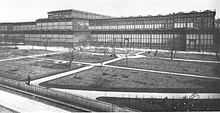Glaspalast (Munich)
- This article is about the building in Munich, Germany. For other glass palaces, see Glass Palace (disambiguation).


The Glaspalast (Glass Palace) was a glass and iron exhibition building in Munich modeled after The Crystal Palace in London. The Glaspalast opened for the Erste Allgemeine Deutsche Industrieausstellung (First General German Industrial Exhibition) on July 15, 1854.
Construction
The Glaspalast was ordered by Maximilian II, King of Bavaria, built by MAN AG and designed by August von Voit, and hosted many large art exhibitions and international trade fairs.
The two-storied building was 234 meters (768 ft) long and 67 meters (220 ft) wide. The building's height measured 25 meters (82 ft). Construction was a mere six months, beginning December 31, 1853 and ending June 7, 1854, during which time 37,000 windows were installed. The total cost of construction was 800,000 guldens.
The Erste Allgemeine Deutsche Industrieausstellung opened five weeks later, only three years after the completion of the Crystal Palace in London, which served as its model.
Electrification
In 1882 die erste elektrisch beleuchtete Internationale Elektrotechnische Ausstellung (the first electrically lit international electrotechnical exhibition) took place in the Glass Palace. The German engineer Oskar von Miller had built a DC overhead power line from Miesbach, 50 km distant, to bring power to Munich. At the exhibition, an electrically powered pump for an artificial waterfall demonstrated the feasibility of bringing electrical power over long distances.
Fire
.jpg)
The building was destroyed in a fire on June 6, 1931,[1] a fate shared with the other crystal palaces. The cause of the fire was later determined to be arson. The fire in the Glaspalast damaged more than 1,000 paintings and sculptures and destroyed more than 110 artworks from the early 19th century including many paintings by Caspar David Friedrich, Moritz von Schwind, Karl Blechen and Philipp Otto Runge. Only 80 artworks were salvaged after the fire.
After the fire, plans were made to rebuild the Glaspalast. However, the plans were abandoned in 1933 after seizure of power by the new Nazi government. Instead of rebuilding the palace, the government built the Haus der Kunst (House of Art) on the Prinzregentenstraße near the Englischer Garten (English Garden).
The fountain of the Glaspalast, which remained intact, today stands in the center of the Weißenburger Platz in the Haidhausen quarter of Munich.
Footnotes
- ↑ The Times, June 8, 1931
Source
External links
- Historisches Lexikon Bayerns: Glaspalast, München (German) Several photographs of the interior and exterior of the Glaspalast
Coordinates: 48°08′32″N 11°33′53″E / 48.14222°N 11.56472°E